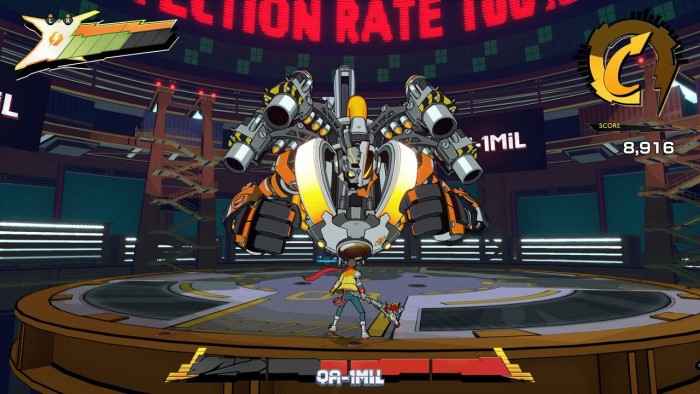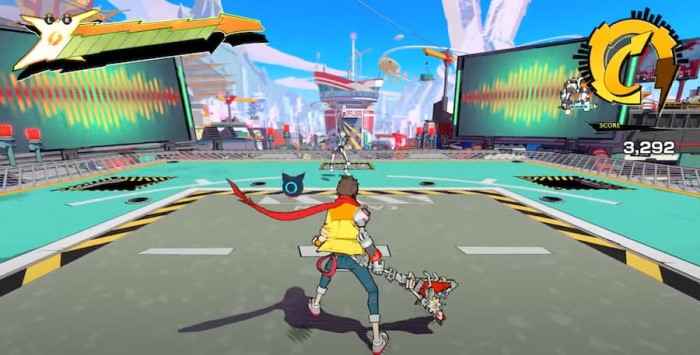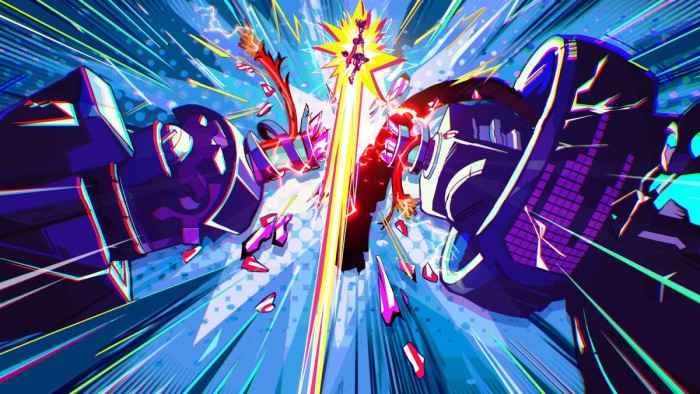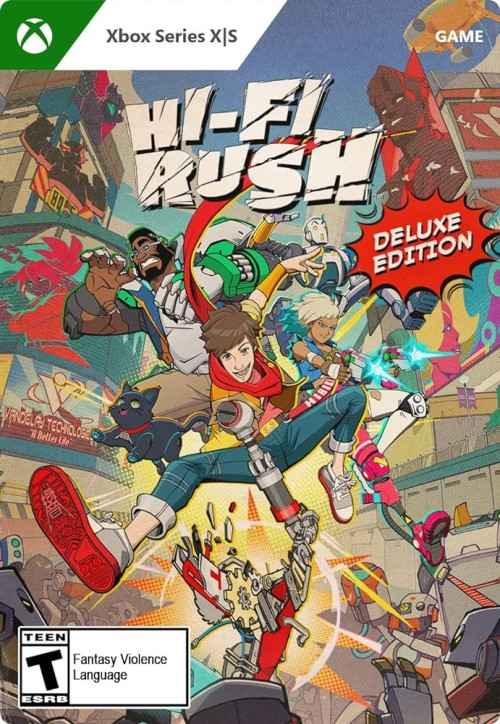Hi-Fi Rush (PS5) Review
Hi-Fi Rush is the latest game from legendary Capcom developer Shinji Mikami’s studio, Tango Gameworks. So far, they haven’t strayed far from Mikami’s Resident Evil roots, making the Evil Within games, and Ghostwire: Tokyo. But their newest game is a bright splash of family friendly color! Hi-Fi Rush merges third person action and music rhythm gameplay, with Disney-like visuals. The game was originally released for Xbox Series X/S and PC in January 2023, but as of March 2024, PlayStation 5 owners will also have access.
The game is about a guy named Chai, who volunteers for a cybernetic enhancement program, so he can become a rock star. The owner of the company doing the enhancements flippantly tosses Chai’s iPod into the machine doing his procedure. When Chai comes out, he’s labelled as a defect, and robot workers try to destroy him. His new procedure has also given him the ability to fight, and he fights to the beat of music that plays throughout the game. The story is nothing special, but it services the gameplay and world well enough.
Chai Sucks
But Chai is a very unlikeable protagonist. From the very beginning of the game, he’s presented as someone who would literally give their right arm to be famous. He interrupts people, cuts in lines, and has all the unlikeable qualities of a young teenager addicted to Jake Paul. From the other characters’ reactions to him, it’s obvious he’s supposed to be annoying. But I don’t get how this could add to anyone’s enjoyment of the game. He isn’t a good kind of annoying.

The easiest comparison to make when explaining Hi-Fi Rush’s gameplay is 2022’s Metal: Hellsinger. That game was a first-person shooter that gave bonuses when players timed attacks to the songs that were playing throughout the game. Hi-Fi Rush has the same concept, but with a third person action game. But the combat is so basic! The player strings together simple combos using a light attack that lasts one beat, and heavy attack that lasts two beats. There’s also a dodge that can be used to string combos, and special attacks that can be released with a full gauge, by pressing both joysticks down.
So Simple
I can tell the developers of Hi-Fi Rush intended for combat to be simple, with getting higher scores being the real challenge. Every battle gives the player a rating, Devil May Cry-style. But I didn’t enjoy the base gameplay enough to play for higher scores. The boss fights are a gameplay highlight though, because they add some pattern memorization and QuickTime events to the otherwise repetitive combat. I would have enjoyed Hi-Fi Rush a lot more if it was just a boss rush.

A music-based game had better have some awesome music, and, to be honest, I didn’t like the soundtrack much. The rock songs Hi-Fi Rush uses are like the tracks in the beginning stages of Rock Band. They are mostly simple rock songs, with a few electronic tracks with rock beats sprinkled in. Those electronic tracks by Prodigy and Nine Inch Nails were my favorites. Anyone hoping for some complex jazz or heavy metal won’t find it here. They are all songs with simple timing, written to appeal to mass audiences. One very cool part about the soundtrack though, is that Hi-Fi Rush uses licensed songs, but there is actually an alternative playlist created for streamers, using non-licensed music. These songs are similar to the licensed tracks, but it’s such a cool feature to have an entire second set of songs to play through.
Off-Time
For a timing-based action game, I felt like the whole game’s timing and pacing was off. The levels are very boring to go through. They have very straightforward layouts, and involve basic platforming. I didn’t like Chai’s jump. It’s like the jump in Ghosts ‘N Goblins, where there’s a set arc to the jump, and no adjusting once the character leaves the ground. And the scoring system is based on keeping simple beats. Chai’s strikes auto time to the beat, so you don’t really know how your strike is going to hit sometimes. It’s easy to hit the attack button while Chai is landing an attack, but sometimes his animations messed me up. I actually enjoyed dodging the enemies’ attacks, knowing they would land on beats, more than I did attacking on beats.

There’s a hideout that can be explored between levels. It acts as a hub world, and gets added to as the story progresses, and as the player completes in-game challenges. The player can spend gathered gears for new combos, special attacks, stat upgrades, etc. There’s also a wardrobe section, where players can customize Chai’s appearance. This adds a lot of replayability to Hi-Fi Rush, as does its multiple difficulty options, and scoring systems.
Visually Delightful
The clear high point of experiencing Hi-Fi Rush is its outstanding visual presentation. From a distance, the game looked like a vibrant, neon-drenched vibe game like Jet Grind Radio. But it’s actually made up of really beautiful cell-shaded models that look like something from a modern Disney cartoon. The color palette really pops, and the interface looks like it was ripped right out of Persona 5. The cutscene animation also has the jerky movement style that’s been popularized by the Spider-Man: Into the Spider-Verse movie. The entire game is always stunning to look at. I should also mention that the voice acting is excellent throughout.

I thought I was going to love Hi-Fi Rush, but I didn’t. There is the kernel of something interesting here. Maybe if they used house music and had the player blending tracks during attacks it might have been more musically engaging. It’s a game that would have worked much better for me in arcade-y, short bursts, because playing through the levels was a slog. The gameplay is so simple that it actually might work well as an intro action game for someone new to the genre. But there are way better rhythm games, and way better third person action games out there. I know a lot of people love Hi-Fi Rush, so if you’re curious I would still give it a chance, but my experience was underwhelming.
***PS5 code provided by the publisher***
The Good
- Vibrant visuals
- Fun boss fights
- Two soundtracks to choose from
The Bad
- Basic action gameplay
- Levels feel like a chore
- Unlikeable protagonist

